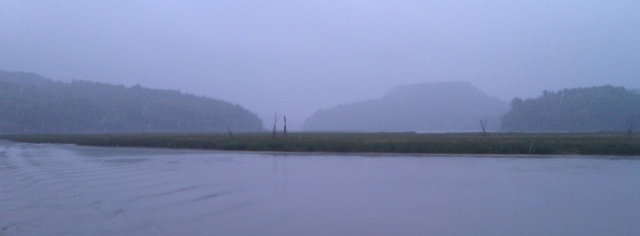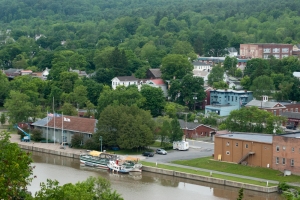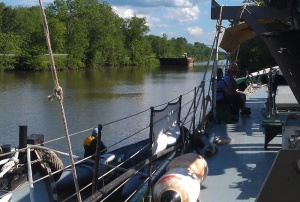At 10:00 a..m. on May 31st, the tug C. L. Churchill towed the replica Lake Champlain Canal schooner Lois McClure, with the outboard-powered, inflatable boat Oocher standing by, out of her narrow berth at Perkins Pier in Burlington harbor. We were getting underway for the schooner’s tenth voyage, a four-month trip carrying a cargo of history on a tour of New York and Canadian canals, canals that, as we pointed out on the cover of our visitors’ brochure, were “born of the War of 1812.” The McClure is embarked on a three-year project to commemorate the 200th anniversary of the War and to celebrate 200 years of ensuing peace. But she is a cargo-carrier, not a warship, so we make the connection via the historical fact that both New York’s Erie Canal and Canada’s Rideau Canal were inspired, in part, by the two countries’ perceived need for internal waterways on which to move military forces and supplies in the event of recurring hostilities after the Treaty of Ghent in 1815. Happily, the heavy traffic on these canals has been commercial.

Our first port-of-call would be Plattsburgh, New York, where we would be the only floating one on a tour of local museums. We towed out through Burlington harbor on a short towline, for good maneuverability, and, once outside the breakwater, lengthened the hawser out to its full 200 feet and headed north on Lake Champlain. In open water, like the broad part of the lake, where it can get rough, we separate tug and tow, while in protected water, we tow with the tug snugged up on the schooner’s hip. Hip-towing gives us much better maneuverability, but wouldn’t do if waves were big enough to make the boats roll against each other. Once well up into Cumberland Bay, we did put the Churchill on the hip and went in to tie up at Plattsburgh’s big stone pier, Wilcox Dock. The landing was made with Erick Tichonuk, the Lake Champlain Maritime Museum‘s co-director, who had wisely traded his desk for the schooner’s deck for the day, at the conn. The next day, the thunder squalls held off until after closing time, so that not one of our 150 visitors got wet. And the following day’s 150 didn’t even have to worry about rain.
On June 3rd, we towed back south on the lake to our second home port, North Harbor, the Museum’s waterfront at Basin Harbor. The advantage of towing on the hawser was demonstrated as the northwest breeze came up to fresh, about 20 knots. Art Cohn (he’s the man who runs this cruise as the Museum’s Director of Special Projects) and I were in the tug’s wheelhouse, and one roll sent the helmsman’s stool flying. Off Essex, we had to slow to let the two ferries from and to Charlotte both cross ahead of us. A rare coincidental timing of our passage had put us nearly on a collision course with both vessels.

As you may remember from previous logs, the schooner’s berth at North Harbor is complicated. We moor her to a floating dock across from the Philadelphia II, the replica of one of Benedict Arnold’s gunboats of 1776. We hold the McClure in position against the float with one mooring line, an anchor planted off the bow, and two or three long lines to trees, then tie her up to the float with the usual dock lines. This day’s mooring operation was further complicated by the unusually high water in the lake. The floating dock had to be way up in the head of the cove so there would be access to it, but that meant that there wouldn’t be depth enough for the Churchill to bring the schooner alongside it. So we picked up the outside mooring and sent the tug safely to another mooring. Luckily (luck is a huge factor in seamanship), the wind was still in the north and had gone downa lot. We used it to let the schooner’s stern swing round toward the floating dock and then blow us slowly right in alongside it, with help from the Oocher pushing and pulling on the stern as needed.
The next two days at North Harbor gave the crew the chance to move their gear on board for the four months’ trip. Let’s see: foul weather clothing, including the big boots; clothes to keep from sweltering in an Upstate New York heat wave and from getting hypothermia in a cold rain on the Richelieu River in September; Museum semi-uniforms for acting as docents serving our floating museum; four months’ worth of books to read in off-hours; and, yes, computers and I-pads. I understand that some of the younger crew members even brought tiny, portable telephones that can double as cameras! And we loaded plenty more ship’s gear on board: firewood for the cabin stove; one more small, and thus readily portable, anchor; sandwich boards to advertise our presence in our ports-of-call; display panels and brochures for visitors, to tell our story of the War of 1812 and of the role of a sailing canal boat of 1862.
On June 6th, we were ready to cast off. A new crew member was on board for two days, Sarah Harris, a reporter for Vermont’s North Country Public Radio. She prowled the schooner from end to end, on deck and below, microphone in hand, recording not only our answers to her questions, but also the sounds of a vessel underway. By now, perhaps you have heard her program about the Lois McClure. She was a good shipmate.
The lake was as calm as a clock, so we towed on the hip across to the Westport Marina, where we tied up to pump out sanitary tanks and fill water and fuel tanks. Then it was south on the lake for an overnight stop at Crown Point. I’ve waxed somewhat poetic about this lovely, protected berth in previous logs, even pausing to try to describe it by moonlight, but on this night, there was no moon to be seen.In the morning, we continued south to Whitehall in a light drizzle. North of Larrabee’s Point, we passed a large snag, apparently most of a tree, with one end struck in the mud 25 feet below the surface and the other end barely showing. It will probably be there for awhile, so we marked it on the chart for future reference. If it becomes a semi-permanent fixture, it will show up on all charts.
When we got to Larrabee’s Point, sure enough, there was the cable ferry coming across exactly on a collision course. So, again, we slowed to let him cross our bow, giving him extra room because of the cable hanging off his stern. Off Fort Ticonderoga, we met the tour boat Carillon returning from Whitehall to her dock at Larrabee’s Point, Shoreham. She is a wonderful-looking craft, long and slim, and, as usual, she was running fast and leaving little wake. We exchanged whistles with her skipper, Paul Sanger, and waves with her happy passengers.

The south end of Lake Champlain is spectacular in any weather. On this misty day, with low clouds obscuring the higher elevations, it was eerily beautiful. When we got to Fiddler’s Elbow, we slowed off the late Cora Archambault’s house and gave the memory of that great lady respectful, loving music from the tug’s horn. After being lifted through Lock 12 at Whitehall, the first of many locks on this trip, we made a nice, soft landing on the wall by the Skenesboro Museum, with First Mate Tom Larsen at the conn.

On June 8th, the citizens of Whitehall turned out in force as they always do for our visit to their historic town (Skenesboro, birthplace of the U. S. Navy, is the claim), and, as always, enlightening discussions reverberated in the cargo hold. The visitors included Bob Dollar, a longtime Museum volunteer who is an expert on rope and ropework and is responsible for our heavy-duty rope fenders on both the schooner and the tug.
The next day, we started south on the Champlain Canal toward an overnight stop at Schuylerville. Anyone looking for an apt definition of an “obstacle course” could do worse than offer the comparison to a canal. June 9th provided an example. At Lock 11, the light was red and the lock keeper reported on the radio that an essential part needed to be replaced. The delay turned out to be only an hour.

Then, after Lock 7, it took time to negotiate our way through the huge dredging project downstream of Fort Edward, where General Electric is cleaning out mud contaminated with pcbs, including meeting a big barge in the narrow approach to Lock 6. He needed most of the channel, so we eased to a stop way over in the trees, where, luckily, there was deep water. One of my favorite things about living on a boat is not having to rake leaves, but I found myself on this day doing just that. Off Lock 5, we stopped briefly to let Bob Foster’s stern-wheel tour boat, the Caldwell Belle, exit the lock and head upstream. Tied up to the approach wall to Lock 5 at Schuylerville just after 6:00 p.m. After supper on deck, all hands turned in early.

On June 10th, the obstacle course turned into a race course. The trip down to Waterford is mostly in the Hudson River, with minimal canal work. There had been a good deal of rain up river, so we had a favorable current of up to two knots. You wouldn’t think that it would feel much different traveling at 7 knots instead of at 5 knots, but it does. Instead of “When are we going to get there?” it’s “Are we there already?” As we approached Lock 2, we heard from the keeper that he was just lifting some boats coming up, so it would be 20 minutes before he’d be ready for us to enter the filled lock. So, to avoid being pushed too close to the lock by the current, we chose to turn into it, using the Oocher to shove the bow round while staying in the channel, and then just headed up into the current at idling speed, which kept us about stationary in the river. When we saw the lock gates open, we Ooched back around and headed in.

By 2:00 p. m., we were all the way down to Waterford and turning into the port. We went right into Lock E2, the first lock on the Erie Canal. And moored to the wall just above the lock. We would have tied up down in the port, but John Callaghan, Deputy Director of the New York Canal Corporation, warned that there was a forecast of heavy rain in two days and that the canal might have to shut down. In that case, we’d be best off separated from the Mohawk and Hudson Rivers in spate by Lock E2.
It’s now two days later, and we haven’t moved an inch. The Erie Canal is shut down due to high water and heavy current in the Mohawk. And this is before the big rain due late tomorrow. We are standing by, waiting to see how much flooding there may be and how soon we can resume our journey. Meanwhile, we are in a perfectly safe berth, and the Canal Corporation folks and local citizens are committing random acts of kindness. Mercy!
Roger Taylor
Captain

Pingback: The Captain’s Log, Part 2 | Lake Champlain Maritime Museum